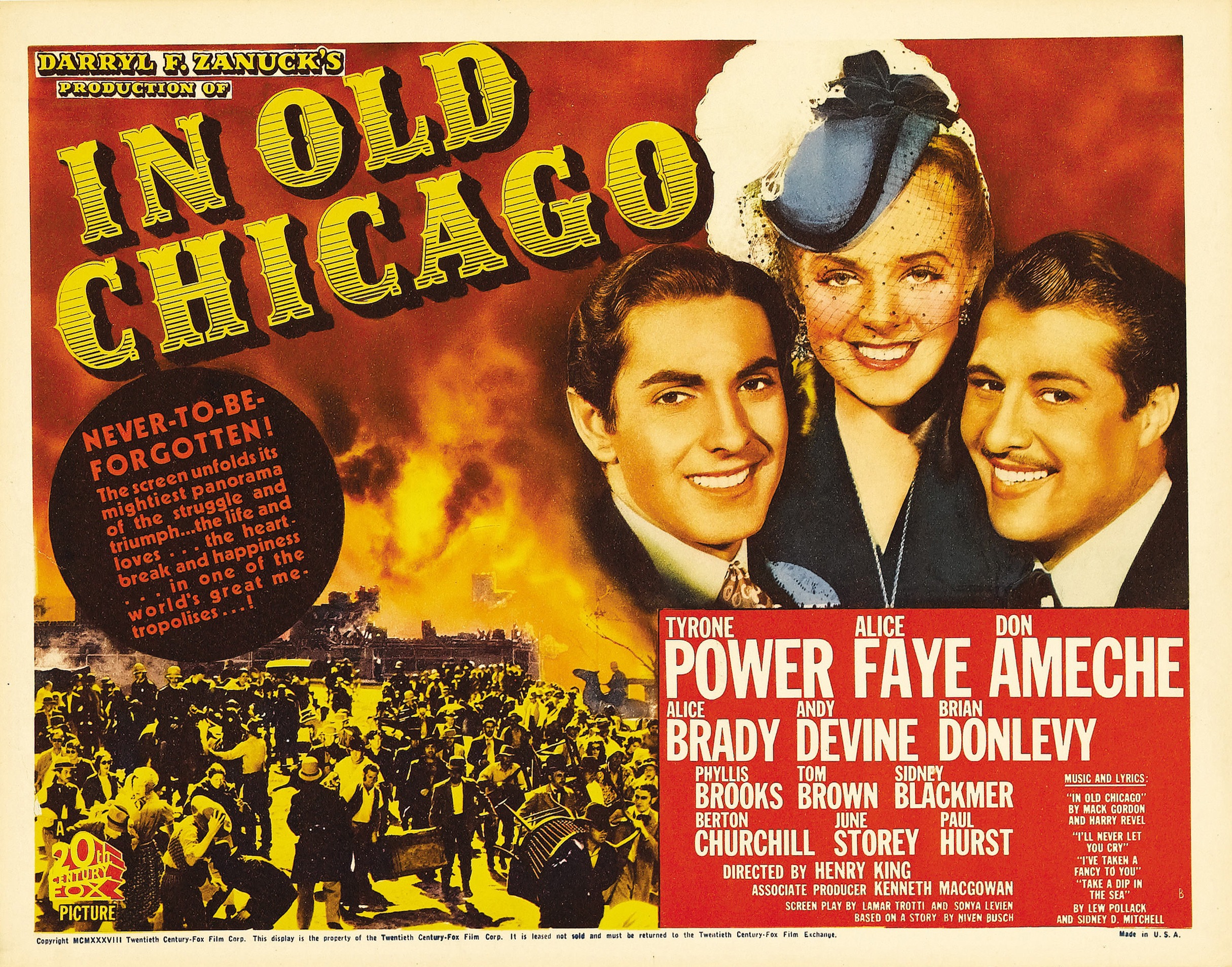At the beginning of In Old Chicago, Darryl F. Zanuck’s 1938 disaster epic about the Great Chicago Fire, this message flashes across the screen: “WE ACKNOWLEDGE WITH APPRECIATION THE ASSISTANCE OF THE CHICAGO HISTORICAL SOCIETY IN THE PREPARATION OF THE HISTORICAL BACKGROUND FOR THIS PRODUCTION.”
That was a lovely shout out to a local institution, but In Old Chicago’s story accurately portrays the Chicago of 1871 in only one respect: a whole lot of buildings burned down. That, it turns out, was all that was required to thrill movie audiences.
As the movie begins, the O’Leary family of “Molly” (the mother’s name was actually Kate), her husband Patrick, and her sons Jack and Dian, are driving a covered wagon across the prairie on the last leg of their journey from famine-struck Ireland to Chicago, the burgeoning metropolis where they’ll all win their fortunes. Suddenly, Patrick is pulled off the driver’s seat and dragged to his death by a team of horses. (In reality, Patrick survived the journey to Chicago.) The widow O’Leary (Alice Brady in an Oscar-winning performance) settles in The Patch, a pestilent plot of ramshackle houses southwest of downtown, where she ekes out a living by taking in laundry.
A second message to viewers describes the Chicago of 1854, in faux-Sandburgese, as “A city of easy money, easy ways, ugly, dirty, open night and day to newcomers from around the world…a fighting, laughing, aggressive American city.” (That’s still true, mostly.)
In this crude but exhilarating town, Mrs. O’Leary’s sons become civic big shots, developing a Cain-and-Abel/Goofus-and-Gallant relationship along the way. Jack, played by a young Don Ameche — half a century before Cocoon — is an upright attorney who crusades against election fraud and is elected mayor on a platform of cleaning up The Patch: “Everything that’s rotten in Chicago comes out of The Patch,” he declares. (Most 1870s politicians had lusher facial hair than Ameche’s trademark cheap moustache. Roswell B. Mason, Chicago’s actual 1871 mayor, grew a chest-length beard.)
Jack’s younger brother, Dion (a dashing Tyrone Power) sets out to become the most successful, most connected saloonkeeper in town. Over dinner at the Palmer House, he offers a muttonchopped senator $1,000 a month in exchange for his political and financial support of a saloon on “the busiest corner in town” — with his paramour, chorus girl Belle Fawcett (played by Alice Faye), as the main attraction. It’s in the senator’s interest, because the saloon will allow Dion to control votes in The Patch.
It wouldn’t be a Chicago movie without a subplot about shady politics. Dion accepts $10,000 to support a rival saloonkeeper for mayor — then schemes to put his brother Jack in City Hall instead, despite their differences on reforming The Patch.
“You took his money,” Belle protests when Dion reveals his duplicity.
“Sure, and I’ll vote for him myself if necessary — but I didn’t say how The Patch will vote,” Dion says.
“Why’s that?”
“Politics. He’d knife me if he could, and I simply mean to beat him to it.”
“Why, you dirty dog.”
You really won’t be missing much if you skip the first hour and a half of In Old Chicago and just watch the last 24 minutes. In Old Chicago was one of Hollywood’s original disaster movies. Zanuck was inspired by the success of MGM’s San Francisco, a movie about the 1906 earthquake. The studio spent $500,000 of the film’s $2 million budget to build a replica of 1854 Chicago, then build another replica of 1871 Chicago and burn it to the ground. According to a 1937 Tribune article about the production:
The headquarters of the Palmer house, the Field, Leiter & Co. store, The Chicago Tribune, the old Rice theater, the Manor house, the city hall, the Adams Express company, the Illinois Central, the Goodrich Shipping company, the Nineteenth Regiment armory, Benziger’s bookshop — all these, and hundreds more of the edifices which landmarked the Chicago of 1871, were transformed or erected. The city hall was in stone.
The fire scenes are thrilling cinema. Of course the fire starts when Mrs. O’Leary’s cow kicks a lantern after she’s nipped by a nursing cow. This is Hollywood. Terrified mobs race through the streets. Horse-drawn fire engines careen toward the flames. Buildings collapse or are dynamited to form a firebreak, on orders of Gen. Philip Sheridan. Fleeing the flames, citizens ride their horses or row boats into Lake Michigan (also re-created on a Hollywood lot). At the Stockyards, frightened cattle break down fences and stampede through the streets. (That didn’t actually happen. The Stockyards were far from the fire’s epicenter.)
The scenes would be even more impressive if they had been shot in color. But this is probably the only Great Chicago Fire movie we’re going to get. In 1938, the fire was still part of living memory, and survivors were even invited to a premiere. Mrs. O’Leary’s cow was as much a part of American folklore as Johnny Appleseed or Barbara Fritchie. As the fire has faded from the nation’s consciousness, so has In Old Chicago faded from the Hollywood canon. But as this week marks the fire’s sesquicentennial, you can view it for free on YouTube.
And if you go straight to 1:26:36, you’ll be in for an exciting (if somewhat inaccurate) time.



